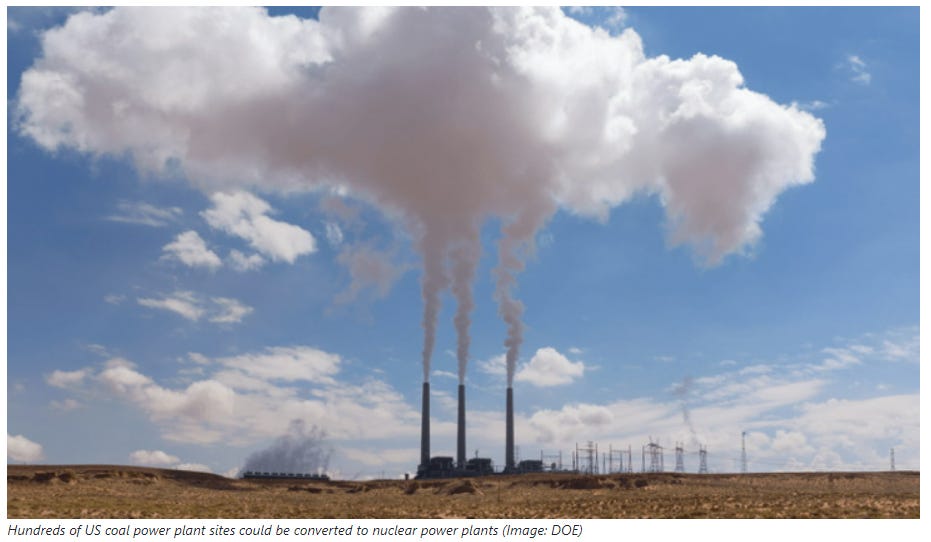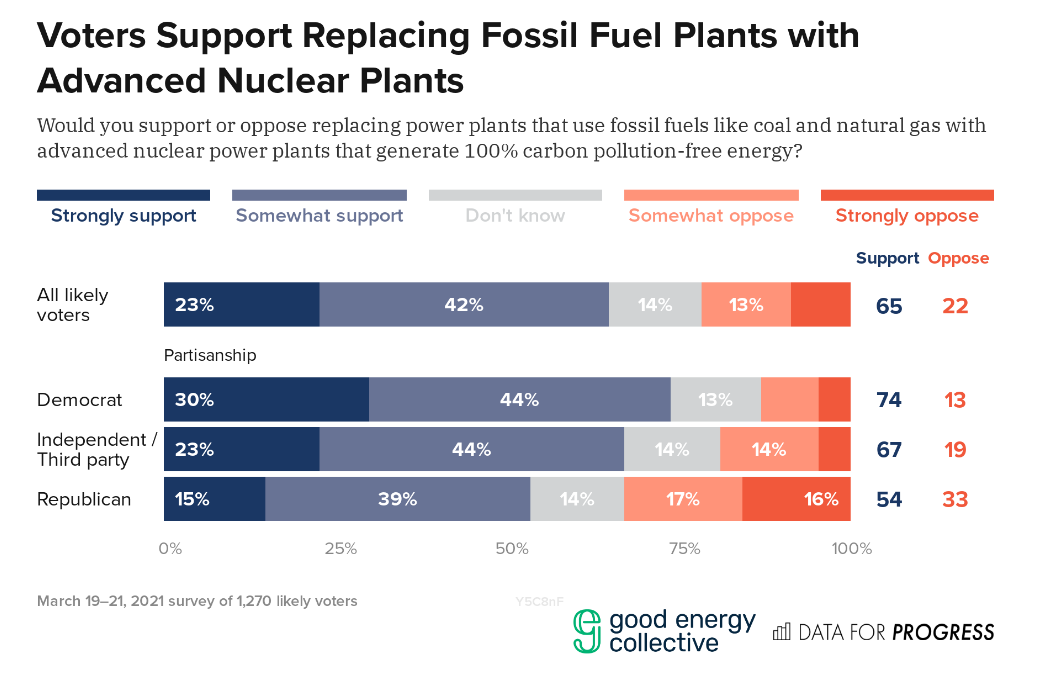Coal to Nuclear is Smart Climate Policy
A new U.S. government report shows huge potential benefits to climate, the economy and justice
What if there was a massive opportunity to accelerate decarbonization, add high-paying permanent jobs, boost the economy and further environmental justice?
It sounds too good to be true, right? But there is.
That’s the message of a new report issued yesterday by the U.S. Department of Energy (DOE) that took a deep look into the possibilities for converting coal power plants in the United States to nuclear power — coal to nuclear, or C2N. The new report emphasizes that it offers a very detailed but still high-level exploration of possibilities and not an evaluation of any specific location for such a conversion.
Still, the findings are tantalizing. The report focused on three questions: “How many CPP [coal power plant] sites in the United States are good candidates? What are the benefits and challenges of transition? How will it affect local communities?”
Here is what the report concluded for each question:
The short answers to these questions are that advanced reactors smaller than a gigawatt scale are amenable to siting at 80% of the CPP sites that passed the first round of screening; repurposing CPP infrastructure may lead to savings on overnight capital costs that range from 15% to 35%; and depending on the nuclear design under consideration, job growth could increase by over 650 new, permanent jobs leading to nearly $270 million in new economic activity, and GHG emissions in a community could fall by as much as 86%.
Specifically, the DOE analysis “identified 157 retired coal plant sites and 237 operating coal plant sites as potential candidates for a coal-to-nuclear transition.” I estimate that these 394 sites converted to nuclear would in principle be able to provide more than 3,400 terawatt-hours of electricity, which amounts to about 70% of all 2021 U.S. electricity generation. That full potential is unlikely every to be realized, but regardless, the scale of the opportunity is massive.
C2N is not just a theoretical idea, but according to World Nuclear News is already being implemented:
The possibility of replacing coal power plants with nuclear capacity is being actively explored in the USA and elsewhere. TerraPower in 2021 announced plans to build a demonstration unit of its Natrium sodium-cooled fast reactor at a retired coal plant site in Wyoming; earlier this year, the the Maryland Energy Administration announced its support for work to evaluate the possibility of repurposing a coal-fired electric generating facility with X-energy’s Xe-100 small modular reactor; and Holtec International recently said it is considering coal plant sites as possible locations for its SMR-160 with plans to bring the first unit online as early as 2029. In Poland, NuScale is exploring with energy company Unimot and copper and silver producer KGHM possibilities for its reactors to replace coal-fired power plants.
Coal to nuclear provides obvious environmental benefits, including much less greenhouse gas emissions and particulate air pollution. But the transition also offers other potential benefits, notably jobs and economic growth. The DOE report explored a hypothetical C2N project in the U.S. Midwest and concluded:
[T]he economic impact results suggest that over 650 new, permanent, long-term jobs would be created in the community. These jobs are distributed across positions at the power plant, the supply chain, and in the community. These are net jobs, so this means that over 650 new positions are created after displaced coal workers are redistributed into new occupations in the economy. New jobs mean new economic activity in the region. The results suggest that economic activity could increase by as much as $275 million, of which $102 million is new labor income (i.e., wages).
Nuclear jobs are higher paying and require greater expertise. There are also more permanent jobs associated with nuclear power than with solar or wind. The study also found positive environmental justice outcomes linked to a transition:
The second takeaway with respect to economic potential is that C2N transitions may be an economic boost for disadvantaged communities. Noted earlier, the economic impacts in the case study show noticeable economic opportunity for communities. Through the lens of social and environmental justice—review of the case study site showed economic disadvantages relative to the state and national comparison—job growth and increased economic activity suggest an improved quality of life in the region.
The conclusions sound quite promising.
For a reality check I contacted one of my go-to experts on nuclear energy policy, Dr. Jessica Lovering who is the founder and co-director of the Good Energy Collective. Last December Jessica co-authored a report that also looked at the potential for C2N conversions and also found the idea to have considerable merit:
Several analogs between coal and nuclear power plants make the technology a potentially attractive energy option for coal-closure communities. Nuclear jobs are as well or better-paying than coal jobs, and certain designs may offer more jobs than the retiring coal plant. Like coal-burning facilities, nuclear plants support the local economy through tax revenue. Many advanced nuclear designs will also be able to produce a comparable amount of power to coal plants and take up significantly less space than wind and solar to generate similar amounts of energy. Similarly attractive is advanced nuclear’s ability to locate within existing coal plant sites and take advantage of the existing water, transportation, and transmission infrastructure. Critically, nuclear energy has zero operating emissions and very low carbon intensity over its lifetime, on par with that of offshore wind, mitigating the environmental and public health impacts for the local community.
The Good Energy Collective analysis identified fewer potential sites as candidates for conversion than did the DOE (79 vs. 394), which Jessica tells me is the result of more stringent criteria that they employed: “The difference is we were focusing on finding the most feasible, likely to be successful sites, whereas the DOE report was looking for all potential sites.”
Whatever the number is, there is huge potential here, not least because these sites are already being used for power generation and will have associated infrastructure such as connection to the electricity grid. That eliminates one of the trickiest issues in the energy transition, the siting of new energy technologies.
Perhaps that helps to explain the broad public support for the notion of C2N. Jessica also pointed me to polling conducted by her organization that indicates that coal to nuclear proposals are supported across the political spectrum, with very low numbers of strong opponents. It is a rare energy policy proposal that enjoys such bipartisan approval.
There are all sorts of proposals for how best to decarbonize the U.S. electricity sector. The current favored approach, adopted under the Inflation Reduction Act, is to lavish wind and solar with massive subsidies in hopes that these carrots will compel both a large expansion in deployment in renewables and a corresponding decrease in the utilization of fossil fuel energy. As readers here will know, I am somewhat skeptical of the claims made for decarbonization under the IRA.
C2N offers large potential for significant progress on decarbonization of the electricity sector, not just in the U.S. but around the world as well. Lovering tells me:
Globally, the opportunity is even larger. There are 2,200GW of operating coal plants producing about 10,000TWh of electricity every year. If these were replaced with nuclear, that would be about 1,000GW, which is more than twice global nuclear capacity today. Importantly, almost all of this capacity is in places that already have nuclear power, are ready for nuclear, or will be ready by 2030.
Coal to nuclear has large potential to benefit the climate, the economy and people’s lives, especially those who have often not benefitted from or have been harmed by past energy technology deployment. This potential alone means that C2N deserves a prominent place in our collective decarbonization policy took box. The possibilities of coal to nuclear are simply too promising to ignore. C2N deserves a much larger role in climate policy discussions.
Paying subscribers to The Honest Broker receive subscriber-only posts, regular pointers to recommended readings, occasional direct emails with PDFs of my books and paywalled writings and the opportunity to participate in conversations on the site. All paid subscribers get a free copy of my book, Disasters and Climate Change at this link. I am also looking for additional ways to add value to those who see fit to support my work.
There are three paid subscription models:
1. The annual subscription: $80 annually
2. The standard monthly subscription: $8 monthly - which gives you a bit more flexibility.
3. Founders club: $500 annually, or another amount at your discretion - for those who have the ability or interest to support my work at a higher level.






Had this been done in TX, we probably wouldn't have had the February fiasco. No worries about the lack of sun and wind; no worries about the lack of fossil fuel; no worries about too few interconnects to external power sources.
Now if we can just get by the NIMBYs...
One question – what is the likely "water intensity" of the nukes vs coal?
Availability of fuel is an issue. For 20 years, starting in 1992, the Megatons to Megawatts project arranged for the US to buy highly enriched U-235 from Russian warheads to be blended down into reactor fuel. Great idea, but it inhibited US uranium mining and enrichment capacity. By 2022, Russia was providing 50% of the world's enrrched uranium and 25% of fuel for the existing US fleet. In the present geopolitical climate, being dependent on Russia does not seem like an optimal scenario, as Germany discovered. It will take a parallel effort to improve US fuel capacity for this admittedly excellent idea to work. Perhaps getting rid of the now-ludicrous once-through fuel cycle, and copying France in reprocessing spent fuel, would go a long way to solving the problem.